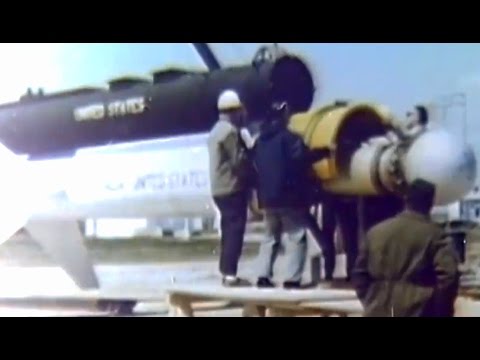NASA & Space Miscellany playlist:
more at
“This film provides an overview of activities on Wallops Island, where the Wallops Flight Facility — one of the oldest launch sites in the world — tracking stations, long-range radar, and data processing capabilities made it a center for the support of space science research and development into orbital and sub-orbital payloads.”
NASA film HQ-137
Sorry the quality of the original film to video transfer on this one is low, but few people know much about this substantial NASA facility.
Reupload of a previously uploaded film with improved video & sound.
Public domain film from NASA, slightly cropped to remove uneven edges, with the aspect ratio corrected, and one-pass brightness-contrast-color correction & mild video noise reduction applied.
The soundtrack was also processed with volume normalization, noise reduction, clipping reduction, and/or equalization (the resulting sound, though not perfect, is far less noisy than the original).
Wallops Flight Facility (WFF) (IATA: WAL, ICAO: KWAL), located on the Eastern Shore of Virginia, is operated by NASA’s Goddard Space Flight Center, primarily as a rocket launch site to support science and exploration missions for NASA and other U.S. government agencies. WFF includes an extensively instrumented range to support launches of more than a dozen types of sounding rockets, small expendable suborbital and orbital rockets, high altitude balloon flights carrying scientific instruments for atmospheric and astronomical research and—using its Research Airport—flight tests of aeronautical research aircraft including unmanned aerial vehicles. There have been over 16,000 launches from the range at Wallops since its founding in 1945.
The WFF range supports science missions for the National Oceanic and Atmospheric Administration (NOAA), and occasionally for foreign governments and commercial organizations… In addition to its fixed-location instrumentation assets, the WFF range includes mobile radars, telemetry receivers, and command transmitters… The WFF mobile range assets have been used to support rocket launches from locations in the Arctic and Antarctic regions, South America, Africa, Europe, Australia and at sea. Workers at Wallops include approximately 1,000 full-time NASA civil service employees and contractors, 30 U.S. Navy personnel, and 100 NOAA employees.
History
In 1945, NASA’s predecessor agency, the National Advisory Committee for Aeronautics (NACA), established a rocket launch site on Wallops Island under the direction of the Langley Research Center. This site was designated the Pilotless Aircraft Research Station and conducted high-speed aerodynamic research… In 1958, Congress established NASA, which absorbed Langley Research Center and other NACA field centers and research facilities. At that time, the Pilotless Aircraft Research Station became a separate facility – Wallops Station – operating directly under NASA Headquarters in Washington, D.C… In 1974, the Wallops Station was named Wallops Flight Center. The name was changed to Wallops Flight Facility in 1981, when it became part of Goddard Space Flight Center in Greenbelt, Maryland.
In the early years, research at Wallops concentrated on obtaining aerodynamic data at transonic and low supersonic speeds. Between 1959 and 1961, Project Mercury capsules were tested at Wallops in support of NASA’s manned space flight program before astronauts were launched from Cape Canaveral Air Force Station in Florida. Some of these tests using the Little Joe booster rocket were designed to flight-qualify components of the Mercury spacecraft, including the escape and recovery systems and some of the life support systems. Two rhesus monkeys, Sam and Miss Sam, were sent aloft as pioneers for astronauts; both were recovered safely.
Since 1945, the Wallops Test Range has launched more than 14,000 research vehicles in the quest for information on the flight characteristics of airplanes, launch vehicles, and spacecraft; and to increase the knowledge of the Earth’s upper atmosphere and the near-space environment. The launch vehicles vary in size and power from the small Super Loki meteorological rockets to orbital-class vehicles…
Since 2001, engineers at NASA Wallops Flight Facility have been developing new range technologies, systems and approaches to improve the cost and responsiveness of launch and flight test activities, within the constraints of available funding and program schedules.
Specifically, NASA Wallops has been leading two range technology development projects: the Autonomous Flight Safety System (AFSS) and the Low Cost TDRSS Transceiver (LCT2)…

